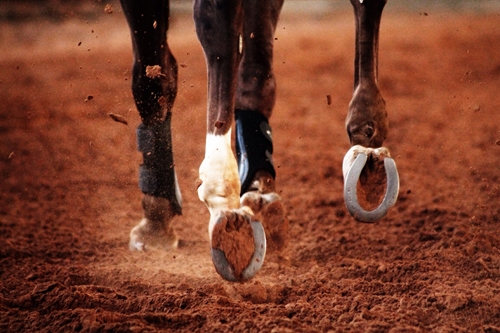Thrush is common but, thankfully, also easily treated.
Thrush is a common infection among horses. It is caused by the bacteria spherophorus neaophorus and results in a strong, foul odor and black discharge. The bacteria eats the tissue around the horse’s frog, the triangular portion of the heel that sits between the sole, wall and bars. The infection does not usually lead to lameness, although this is a possibility if left untreated.
“Thrush is most common in horses with unhealthy frogs.”
How do horses get thrush?
According to Practical Horseman, the idea that horses develop thrush because they stand in an unclean environment is incorrect. Thrush is actually most common in horses with unhealthy frogs. These frogs are generally smaller than they should be and somewhat out of proportion – that is, their width is less than 70 percent of their length. An unhealthy frog also does not align with the rest of the foot’s surface, and therefore, does not touch the ground the way a healthy frog should. It’s small size and lack of contact with the ground causes it to atrophy, creating deep grooves that are a perfect environment for bacteria.
Preventing thrush
If your horse’s frogs recede, have your farrier trim the hoof so the frog and the heels of the hoof capsule are aligned and both touch the ground. This will also help an infected frog heal more quickly.
Even though a dirty stall does not cause thrush directly, it is best to keep your horse’s environment clean and dry. Additionally, as Equus Magazine notes, your horse’s hooves expand and contract with each step, pushing out dirt and thrush-causing bacteria.
Do not wait until your horse develops thrush to call a farrier. Having a farrier visit regularly keeps your horses hooves healthy and will help you spot an infection before one spreads.
Treating thrush
If your horse does develop thrush, keep him or her in a clean environment. Make sure the area and your horse’s hooves are dry, as the bacteria thrives in constant moisture. You may need to switch your horse’s bedding for one that dries quickly such as shavings or saw dust. In addition, you should switch from acidic footing such as shredded conifers. These alter the pH of the soil as they decompose, making it easier for bacteria to grow. These environmental changes help stop your horse’s condition from progressing.
To begin treatment, your farrier will cut away at any diseased tissue, then clean the area with diluted bleach and follow with an astringent. However, the Merck Veterinary Manual advises owners to use a paste made of metronidazole tablets instead of astringent if any sensitive tissue was exposed earlier in the treatment process. You should continue cleaning the hoof as advised by your farrier to prevent the thrush from developing again.
Regular cleanings, exercise and inspections should minimize your horse’s chances of thrush , but it’s not the end of the world if the condition comes back. Just keep an eye on your horse’s frog health and actively address any sole issues.








